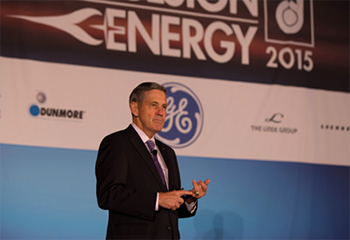Kennedy Space Center Evolves to Serve New Generation of Space Explorers Written 29 July 2015
Speaker: Robert Cabana, NASA’s Kennedy Space Center
By Duane Hyland, AIAA Communications (2008-2017)

Long considered the nerve center of the U.S. space program, the site of NASA’s John F. Kennedy Space Center in Cape Canaveral, Florida, has witnessed every manned mission the U.S. has started. With the end of the space-shuttle era in 2011, Kennedy faced an uncertain future with many worrying that the best days of the center were behind it.
Not so, according to Robert Cabana, director of the Kennedy Space Center. Cabana told an audience at “The Transformation of the Kennedy Space Center,” a lecture during the 2015 AIAA Propulsion and Energy Forum in Orlando, Florida, that Kennedy is “rapidly evolving to meet the needs of a new generation of space explorers,” who will need a safe place to leave from and return to as they go about their explorations.
Cabana explained that the center is preparing to host the next generation of launchers and vehicles for the U.S. space program, chief among them the Space Launch System (SLS) and the Orion spacecraft. He said the Kennedy also is expanding to meet the needs of commercial space customers. In order to host these new generations of rockets, NASA and its private space company partners are building new buildings, constructing new launch pad complexes and modifying older complexes.
Cabana said the projects include a revamp of the Vehicle Assembly Building; transformation of the Orbiter Processing Facility into a Commercial Crew and Cargo Processing Facility; a rebuild of Firing Room 1 — the room that launched the Apollo missions; and several other changes. Cabana also said that two new launch pad sites were under development: “one north of 39B and one between 39A and 41.”
Another change, according to Cabana, include the Space Exploration Technology Corp.’s redevelopment of iconic launch pad 39A — which launched nearly every Apollo mission — into a facility to launch its Falcon 9 and Falcon Heavy rockets. Additionally, Boeing Co. has taken over part of the Orbiter Processing Facility for its X-37B unmanned spacecraft project. Kennedy also has teamed with the state of Florida and NASA’s Space Life Sciences Laboratory to create Exploration Park, a research and development facility on the center’s property that will serve as a hub for private enterprise and private-public partnerships.
Among the more challenging of the refurbishment projects, Cabana said, has been the removal of the more than 3 miles of 50-year-old copper wiring and other equipment from the firing control rooms tunnel between the rooms and launch complexes.
Cabana explained that the end of the space-shuttle era brought about a 43 percent reduction in the center’s workforce. However, despite the losses, and the end of the iconic program, Cabana said, “Kennedy Space Center is set to become a thriving hub of government space programs, private space programs and private-public partnerships” that will give explorers a safe place to return.
